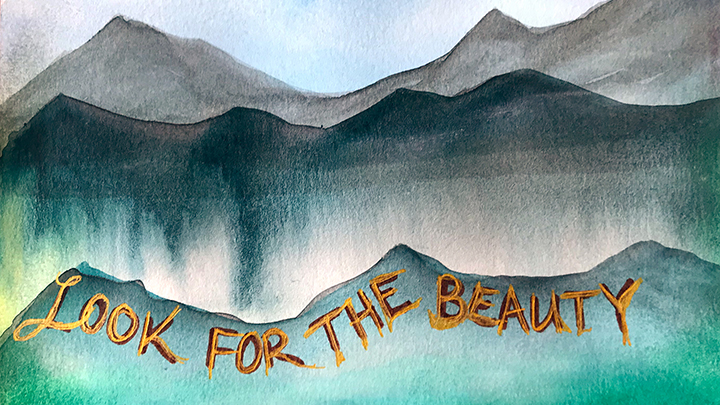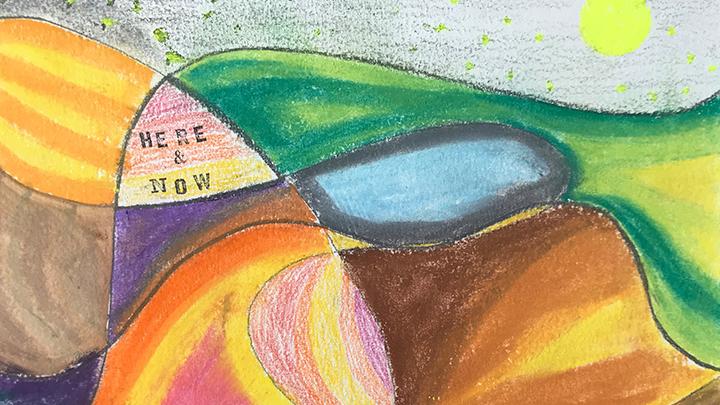
February 24, 2025

In therapy sessions for the Alberta Healthy Living chronic pain management program, patients reflect on what’s meaningful and enjoyable for them. Here’s one of their paintings. Supplied.

During art therapy, participants enjoy an activity which helps them to practise mindfulness and be present in the moment. Here’s another painting. Supplied.
Story by Kelly Morris
Pain can be debilitating and make it difficult to participate in activities that bring joy to our lives. The chronic pain management program of South Zone Alberta Healthy Living Program (AHLP) appreciates the benefits of recreation therapy for their struggling patients.
“Recreation, to me, is what helps people escape some of their health issues and gives them a safe space where they can try things and engage in the world again,” says registered nurse Drake Mccheyne, who leads the program.
“Recreation is important, not just for fun, but it’s something we all need. As we get older, we often put it on the backburner and we don’t have fun anymore.”
When identifying patients’ goals and values, Mccheyne often hears that what they miss most are the hobbies and activities that bring enjoyment and quality of life. That’s when he calls on the South Zone recreation therapy team.
“Our goal is to empower patients to change their pain system to help improve their function, coping and their life while living with pain,” says Shana Wandler, recreation therapy professional practice lead.
The nine-week online chronic pain management program includes one focused session with recreation therapists, as well as sessions with other experts on topics such as pain science, sleep strategies, nutrition, self-compassion and mindfulness, exercise and chronic pain.
“It’s such a collaborative approach, how each discipline can share their knowledge, skills and clinical approach with patients who can then take the information and apply it in their day,” says Wandler.
During a recreation session, participants learn what recreation therapy is, the role recreation plays in our lives, and how it can play a role while living with chronic pain. In an activity called ‘connecting with my best self,’ participants imagine a time in their life when they felt most like themselves as it relates to leisure and recreation.
“We guide them through visual imagery and get them to write down the four key themes that came out from that,” adds Wandler. “It really gets them to think about what's meaningful and enjoyable to them.”
For example, if they used to love golfing, was it being with friends or getting outside in nature, or the competition and movement?
“Recreation therapy is great at identifying what people care about as well as finding ways to do those activities, either by adapting the activity or finding activities that connect with those values,” says Mccheyne.
Patients suffering with chronic pain can lose the desire, motivation or capacity to add anything extra to their day. During recreation sessions, participants engage in an art activity, which provides a reminder that, while recreation isn’t something they have to do, the benefits are worthwhile.
“Art is a modality that’s been used a lot for emotional coping with chronic pain. It’s a great mindfulness activity,” says Mccheyne. “Living with chronic pain, people can easily forget who they are and what they enjoy in life. The art activity helps patients remember, ‘I’m more than just my pain.’”
Wandler describes it as ‘being in flow’ — or the ability to move out of the pain — and into a moment of being.
“We describe the role art can have when living with chronic pain, and the opportunity of being in flow, where the pain is no longer the priority of focus and the individual can be present in the moment,” says Wandler.
“This can be really beneficial for individuals living with pain as it allows for a sense of enjoyment and reprieve from their pain.”
Recreation therapists refer patients struggling with pain to the AHLP chronic pain management program, and AHLP often refers patients to recreation therapy programs, such as aquatic and yoga for chronic pain, when patients have begun to control their pain.
“A lot of patients say, ‘I didn't think, if I had pain, that I could do this.’ They think it’s out of their reach,” says Mccheyne. “I say, ‘if you want to do something, but you don't know what it is, therapeutic recreation can help you do that within your current health as well.’”
Wandler adds: “There's lots of other opportunities that people can still participate in, even though they're living with chronic pain. And that’s what we strive to do — help improve an individual's leisure behavior or function or reduce their pain so they can find meaning and enjoyment in their day.”